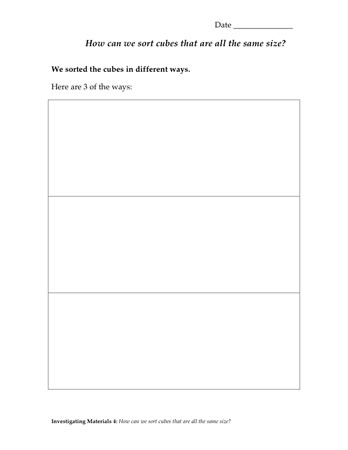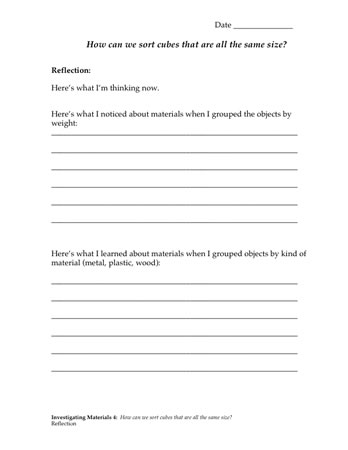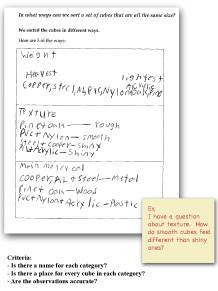How can we sort cubes that are all the same size?
Plan Investigating Materials 4
Short kids … tall kids … big kids … small kids. Growing children are interested in size, and it is one of the first attributes they use to categorize objects. But how can we sort a group of objects that are all the same size?
Formative Assessment
Available online at inquiryproject.terc.edu
Students are challenged to sort the 8 materials cubes at least 3 ways, each time by different properties, e.g., dull vs. shiny or heavy vs. light. Special attention is paid to groupings by weight and type of material. After comparing their results, students add some classroom objects to their groupings.
By the end of this investigation, students will be thinking about the cubes in terms of such categories as weight, color, texture, hardness, luster, and type of material.
Learning Goals
- to become familiar with the range of properties that can describe materials
- to begin organizing properties into larger categories such as color and texture
| Sequence of experiences | ||
|---|---|---|
| 1. Ask the question | All Class | 10 Mins |
| 2. Sort the cubes | Small Groups | 15 Mins |
| 3. Share the data | All Class | 10 Mins |
| 4. Make meaning | Discussion | 10 Mins |
Materials and Preparation
For the class:- Post the investigation question in a place where all students can see it.
- Post the table of properties the class compiled in the last session.
- Gather 10–12 common classroom objects.
- 2 cubes that have been cut in half
- 1 set of the material cubes
Concept Cartoon

The Materials Concept Cartoon is typically used as a formative assessment at the end of this investigation.
Can students organize the properties of materials cubes into larger categories such as color or texture?
Look for evidence on notebook pages. Ask this key question as you interpret their notebook entries:
Have they identified categories that encompass individual properties?
- color: light, medium, dark
- type of material: metal, plastic, wood
- smell metallic, no smell, sap
- texture: smooth, bumpy, rough
- weight of cube: heavy, medium, light
A next step might be to hide one of the cubes behind your back, describe some of its properties, and ask students to identify the cube. Having modeled this "properties game," give students a few minutes to play the game with a partner.









